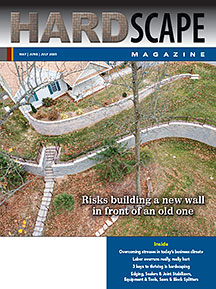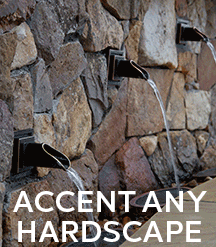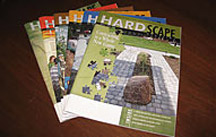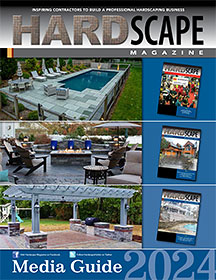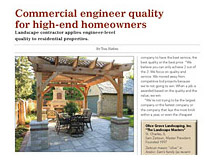Contractor Stories
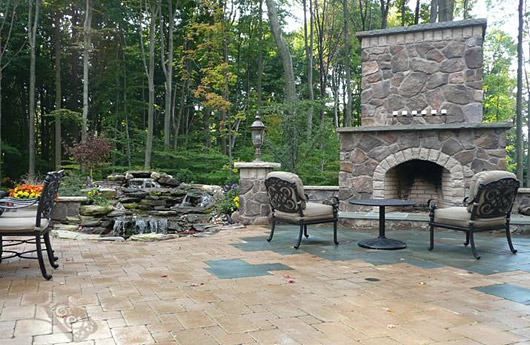
Sure, we can do that
"Can-do" attitude leads to broad construction abilities that allow Vizmeg Landscape to weather a tough economy.
By Tom HatlenNot happy with the direction your river is taking? Vizmeg Landscape will gladly reroute it for you.
Want to landscape a 1:1 slope 80' down that ends in Lake Erie? George Vizmeg says it just takes a little ingenuity and a 55-ton excavator with an 85' reach.
"We never say, 'That's not our thing' – ever," explains George. "We see it as a challenge. It's excitement. That's what makes us go. The guys thrive on that."
Of course, things start small. For example, before rerouting a small river, Vizmeg Landscape rerouted a few tiny streams. Just the same, George didn't jump into it haphazardly. "It takes a little research so you know what you're doing. Then you can build on that when a more challenging project comes along."
With each project, Vizmeg Landscape builds on their internal expertise to the point where they do nearly everything in house including the projects noted above. George says their ability to take on difficult work on a wide range of projects has been the key for them to maintain their company at roughly $8 million in sales right thru the economic turmoil of the last 3+ years.
They have the skills to "go where the money is." If there's not much work in new-build residential landscaping, they can turn their focus to something else like municipal work buoyed by grants. Plus, having a broad range of skills allows them to secure more work from each project they land.
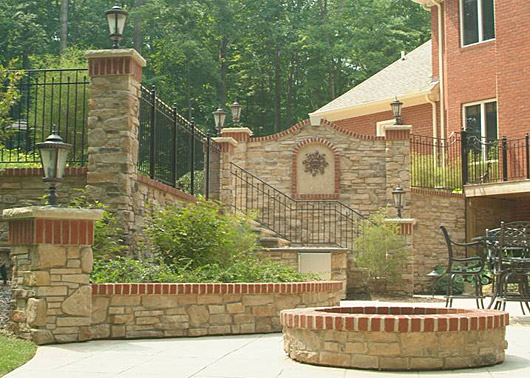
More work from each project
Vizmeg Landscape will need a broad range of skills this spring as they start construction on a high school sports stadium – not just the field. They're also putting in storm sewers, curb & gutter, a ticket booth, entrance walls, fencing, sidewalks and irrigation – enough work to bring the value of the job up to $700,000.In addition, they do high-end design, carpentry, major earth work, planting, stamped concrete, water features, koi ponds, masonry, stone, river restoration, landscape maintenance, etc. They don't electrical or plumbing work.
Construction expertise starts at the top. The 4 Vizmeg brothers (George, Stevie, Jimmie and Mike) all work in the business and they all have a special knack for building things. George and Mike have degrees in mechanical engineering.
ProfileVizmeg Landscape, Inc.Stow, OH George Vizmeg President Customer base Landscape construction 50 residential/ 50% commercial Landscape maintenance 70% commercial/30 residential Services 55% construction 38% maintenance 7% snow removal Largest job size $3.8 million 2010 sales $7.4 million 2011 projected sales $8.5 million Number of employees 80 |
George says Vizmeg Landscape is able to cover the costs of skilled employees because of the efficiencies they gain by doing everything in-house. They're not waiting on other contractors and subcontractors. They control quality and their schedule so jobs are well coordinated and completed on time. There's less travel because they're on jobs longer. Plus, they need fewer jobs.
George says, "Once we start a project, we stay there to the finish. A lot of our competitors, they want to get in and get out. They want to get their cash and run. We're the opposite. We're making money on every segment of it. It's recovering our overhead and paying the employees. It's adding profit. It allows us to take large jobs and produce an end product at a very reasonable cost for the client."
Taking the job no one wants
Of course, what cost is reasonable depends on what you are being asked to do. George says the degree of difficulty for the Lake Erie slope project was such that hiring Vizmeg Landscape was the only option available.The owner wanted to turn the side of the hill into a useable backyard (1:1 slope 80' down to the lake). He wanted patios, steps down to the beach and a pool deck among other things. The project included roughly 3,000 sq. ft. of pavers, 2,000 face ft. of SRWs and 1,200 face ft. of gabion baskets (stacked wire baskets filled with stone).
"You could barely walk up this hill. Landscaper after landscaper told him that it couldn't be done. I looked at it, and I told him I could build it. It's projects like this that set us apart from other people."
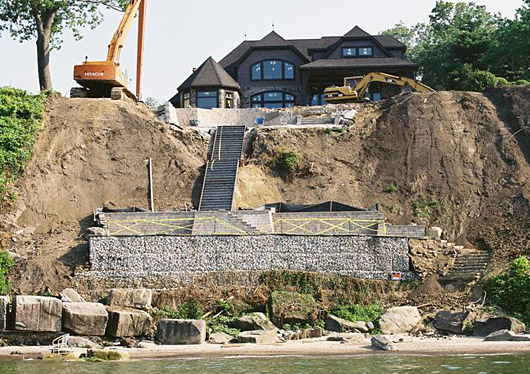
The Lake Erie slope project included a gabion basket wall at the bottom to protect
the shoreline and support the lower patio.
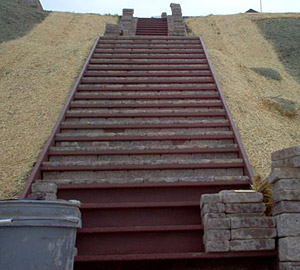 A paver overlay on the steps masks a steel staircase framework beneath. The whole stairway sits on a grade beam held in place by pylons every 6' on-center, each driven 14' to 16' into the ground. |
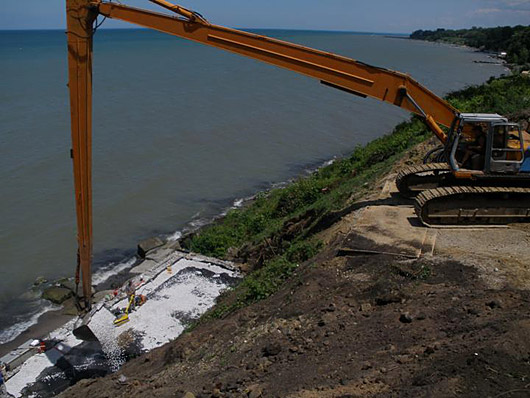
Renting a 55-ton excavator with an 85' reach was the key to installing the Lake Erie slope project.
"We had to have engineers involved. We started at the bottom with gabion baskets to stabilize the shoreline against erosion. We kept running into different unclassified soils that were dumped in there years ago. So we had to be more cautious and use lots of geo-grid. We used geo-grid on all the fill areas: under paver patios and under rows of wall block to help spread the weight out and tie everything back into the hill."
The whole stairway sits on a grade beam held in place by pylons every 6' on-center, each driven 14' to 16' into the ground. The paver overlay on the steps masks a steel staircase framework beneath.
King Kong vs. Godzilla vs. a 110,000 lb. Excavator!
The only access to the work area was from the top of the hill above the lake. That's where the Hitachi EX400LCH excavator came in to play. The excavator was a rental from southern Ohio, 5 weeks for $10,000. Moving it to Cleveland required a police escort with over-weight, over-width, over-length permits. It sat taller than a telephone pole.George says the excavator was central to building the entire job. It sat at the top of the hill where it did nearly all the digging for the project. It drove in pylons using a pile driver attachment. They also used it like a crane to move all materials and equipment (including a mini excavator!) down to the bottom or where ever it was needed.
The operator stayed in the cab all day, even during occasional down time because so much depended on him. "We didn't want the operator jumping in and out and raising his blood pressure. We wanted him to relax and just think about that work without distractions. He's got to be watching what the crew is doing so that when they signal, he knows exactly what to do and no one else is sitting around waiting on him because he's off doing something else."
Before working the excavator they gave the operator a half day to learn it. While they put an excellent operator on the machine, George says plenty of his people could have done it. "It's no different than operating other equipment except it's much, much bigger."
With all the hardscape structure now in place, Vizmeg will finish out with planting and seeding this year.
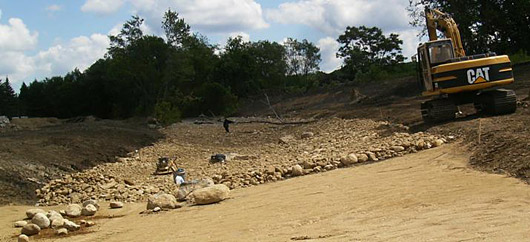
The new riverbed for the Little Cuyahoga is armored by a lining of rock.
Diving into river routing
If you can take the leap to operating huge equipment after operating small equipment, you can make the jump from rerouting tiny streams to rerouting rivers.Last summer George heard about a public bid to rework about 2,000 linear feet of the Little Cuyahoga River as part of the storm water management solution for the new Goodyear Tire headquarters in Akron, OH. The idea was to create a larger flood plain downstream from Goodyear to slow down the rush of water and reduce erosion.
To do this they needed to lower the river banks and re-cut the river bed to make it more winding and longer, 2,400' linear feet. The Little Cuyahoga was 20' to 25' wide and a couple feet deep in that area.
River rerouting recipe for the Little Cuyahoga:
- Dam up the river and pump water out of the river, around the work area and back into the river bed at the other end. In this case, they used two 120hp pumps about 7' tall running 24 hours a day for 70 days, and almost a half mile of 18" diameter tubing.
- Excavate the river bottom to continuously rise and fall with "riffles, pools and runs" to further slow the water flow.
- Install 6" sand layer, compact, and then "armor" the banks and bottom with stone to hold everything in place.
It's just like anything else to George. "You just take a set of plans, understand how it works, and you go out and build it."
Vizmeg went out and built this river bed for $800,000. While there might not be a lot of river rerouting work out there, there is a yet-to-be-awarded 2011 contract for phase 2 for this project that will be about the same size as phase 1. River rerouting means another job in a tight economy, and another credential that makes Vizmeg Landscape stand out and helps keep the company going strong.
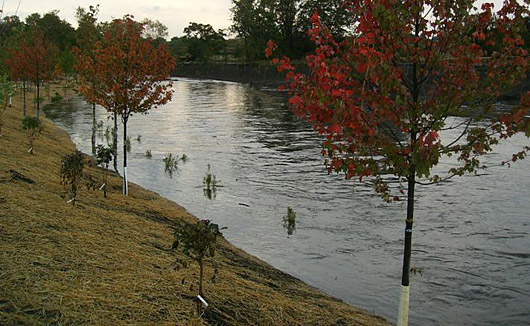
The Little Cuyahoga River rerouted and refilled with water.
The Vander Kooi connectionGeorge says he's always had a knack for building things, but not for pricing them. In 1996 with about 4 years in business, annual sales were just under $1 million. "The following year we would have had to go out of business because we weren't making any money. We weren't charging enough. I had no idea how long a job should take, or how much it would cost us."We had Charles come in and set us up properly so we know what to look for, how to budget man-hours, how to budget overhead and other costs. Now we meet with him 2 to 3 times a year for a couple of hours, and we look at what our overhead budget is. What work we have on the books, how we're doing year to date, what strategy to take moving forward. And I've been able to build my company that way." |






